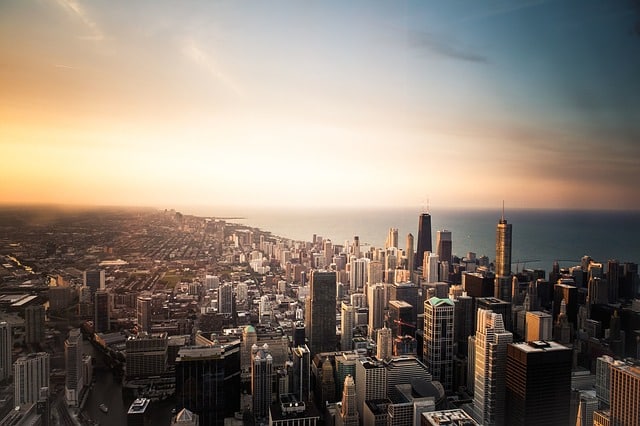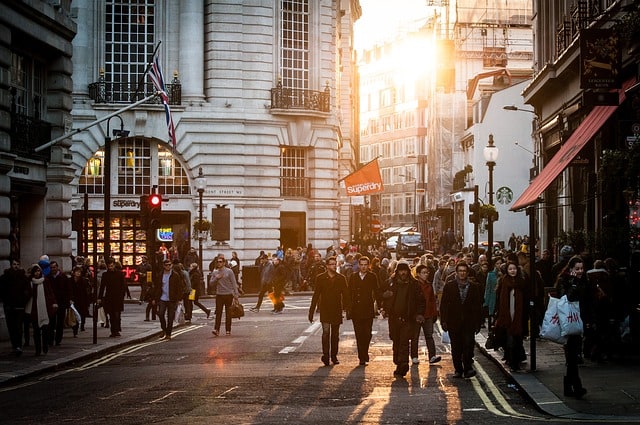what is the largest factor leading to increased urbanization?
What is Urbanization?
Urbanization is a process whereby populations move from rural to urban areas, enabling cities and towns to grow. Information technology tin too be termed as a progressive increase in the number of people living in towns and cities. It is highly influenced by the notion that cities and towns accept achieved better economical, political, and social mileages compared to rural areas.
Accordingly, urbanization is very common in developing and developed worlds every bit more and more people have the trend of moving closer to towns and cities to acquire "privileged" social and economic services as well equally benefits. These include social and economic advantages such as meliorate education, health care, sanitation, housing, business organisation opportunities, and transportation.

According to Wikipedia,
"Urbanization (or urbanisation) refers to the population shift from rural to urban areas, the decrease in the proportion of people living in rural areas, and the means in which societies adapt to this change. It is predominantly the process by which towns and cities are formed and get larger every bit more people brainstorm living and working in central areas."
The bulk of people motion to cities and towns because they view rural areas every bit places with hardship and backward/archaic lifestyles. Therefore, as populations move to more than developed areas (towns and cities) the immediate event is urbanization.
This normally contributes to the development of country for use in commercial properties, social and economic back up institutions, transportation, and residential buildings. Eventually, these activities raise several urbanization problems.
To acquire more than about urbanization, here are its causes, effects, and solutions.
Contents
- Diverse Causes of Urbanization
- 1. Industrialization
- two. Commercialization
- 3. Social Benefits and Services
- four. Employment Opportunities
- 5. Modernization and Changes in the Mode of Living
- 6. Rural-urban Transformation
- Effects of Urbanization on Our Cities
- 1. Positive Effects of Urbanization
- 2. Housing Bug
- iii. Overcrowding
- 4. Unemployment
- 5. Development of Slums
- 6. Water and Sanitation Issues
- 7. Poor Health and Spread of Diseases
- viii. Traffic Congestion
- 9. Urban Crime
- Solutions to Urbanization
- 1. Building Sustainable and Environmentally-friendly Cities
- 2. Provision of Essential Services
- 3. Cosmos of More Jobs
- 4. Population Control
Diverse Causes of Urbanization
1. Industrialization
Industrialization is a trend representing a shift from the old agricultural economic science to a novel non-agricultural economy, which creates a modernized society. Through the industrial revolution, more people have been attracted to motility from rural to urban areas on account of improved employment opportunities.
The industrialization has increased employment opportunities past giving people the chance to work in modern sectors in job categories that aids to stir economic developments.
2. Commercialization
Commerce and trade play a major role in urbanization. The distribution of goods and services and commercial transactions in the modern era has developed modernistic marketing institutions and substitution methods that have tremendously given rise to the growth of towns and cities.
Commercialization and trade come with the full general perception that the towns and cities offering improve commercial opportunities and returns compared to the rural areas.
three. Social Benefits and Services
There are numerous social benefits attributed to life in cities and towns. Examples include better educational facilities, better living standards, better sanitation and housing, better health care, meliorate recreation facilities, and better social life in general.
On this business relationship, more and more people are prompted to migrate into cities and towns to obtain a wide diverseness of social benefits and services which are unavailable in rural areas.
4. Employment Opportunities
In cities and towns, there are ample job opportunities that continually depict people from rural areas to seek a better livelihood.
Therefore, the majority of people often migrate into urban areas to admission well-paying jobs equally urban areas accept countless employment opportunities in all developmental sectors such as public health, education, transport, sports and recreation, industries, and business concern enterprises.
Services and industries generate and increase higher value-added jobs, and this leads to more than employment opportunities.
5. Modernization and Changes in the Mode of Living
Modernization plays a very important role in the process of urbanization. As urban areas become more technology savvy together with highly sophisticated communication, infrastructure, medical facilities, dressing code, enlightenment, liberalization, and other social civilities availability, people believe they can pb a happy life in cities.
In urban areas, people as well embrace changes in the modes of living namely residential habits, attitudes, dressing, food, and beliefs. As a effect, people migrate to cities and the cities grow by absorbing the growing number of people day after day.
6. Rural-urban Transformation
As localities become more fruitful and prosperous due to the discovery of minerals, resources exploitation, or agricultural activities, cities beginning emerging as the rural areas transform into urbanism. The increase in productivity leads to economic growth and higher value-added employment opportunities.
This brings about the need to develop better infrastructure, amend education institutions, improve health facilities, better transportation networks, the institution of banking institutions, better governance, and ameliorate housing.
Equally this takes identify, rural communities offset to prefer the urban culture and ultimately become urban centers that proceed to abound every bit more people move to such locations in search of a better life.
Effects of Urbanization on Our Cities
i. Positive Effects of Urbanization
Urbanization yields several positive effects if it happens within the appropriate limits. Some of the positive implications of urbanization, therefore, include the creation of employment opportunities, technological and infrastructural advancements, improved transportation and communication, quality educational and medical facilities, and improved standards of living. However, extensive urbanization mostly results in agin effects. Below listed points are a few of them.
2. Housing Problems
Urbanization attracts people to cities and towns which leads to a high population increase. With the increase in the number of people living in urban centers, in that location is a continued scarcity of houses.
This is due to insufficient expansion infinite for housing and public utilities, poverty, unemployment, and costly building materials which can only be afforded past a few individuals.
3. Overcrowding
Overcrowding is a state of affairs whereby a huge number of people alive in a small infinite. This form of congestion in urban areas is consistent considering of overpopulation and it is an attribute that increases mean solar day by day as more people and immigrants move into cities and towns in search of a better life.
Virtually people from rural or undeveloped areas always have the urge of migrating into the urban center that unremarkably leads to congestion of people within a pocket-sized expanse.
4. Unemployment
The problem of joblessness is highest in urban areas and information technology is fifty-fifty higher among educated people. It is estimated that more than half of unemployed youths effectually the globe live in metropolitan cities.
And, equally much every bit income in urban areas is high, the costs of living brand the incomes seem horribly low. The increasing relocation of people from rural or developing areas to urban areas is the leading cause of urban unemployment.
5. Development of Slums
The cost of living in urban areas is very high. When this is combined with random and unexpected growth as well as unemployment, there is the spread of unlawful resident settlements represented past slums and squatters.
The growth of slums and squatters in urban areas is even further exacerbated by fast-paced industrialization, lack of developed land for housing, a large influx of rural immigrants to the cities in search of a better life, and the elevated prices of country beyond the reach of the urban poor.
6. Water and Sanitation Bug
Considering of overpopulation and rapid population increase in most urban centers, it is common to find there are inadequate sewage facilities.
Municipalities and local governments are faced with serious resource crunch in the direction of sewage facilities. Equally a outcome, sanitation becomes poor and sewages flow chaotically, and they are drained into neighboring streams, rivers, lakes, or seas.
Eventually, infectious disease such as typhoid, dysentery, plague, and diarrhea spread very fast leading to suffering and even deaths. Overcrowding too highly contributes to h2o scarcity as supply falls short of need.
7. Poor Health and Spread of Diseases
The social, economic and living weather in congested urban areas affects access and utilization of public health care services. Slum areas in detail experience poor sanitation and insufficient water supply which by and large make slum populations susceptible to infectious disease.
Ecology problems such every bit urban pollution also cause many health issues namely allergies, asthma, infertility, food poisoning, cancer and even premature deaths.
eight. Traffic Congestion
When more people move to towns and cities, i of the major challenges posed is in the transport organization. More people means an increased number of vehicles which leads to traffic congestion and vehicular pollution.
Many people in urban areas drive to work and this creates a astringent traffic trouble, specially during rush hours. Also as the cities grow in dimension, people volition movement to shop and access other social needs/wants which oft crusade traffic congestion and blockage.
ix. Urban Crime
Bug of lack of resources, overcrowding, unemployment, poverty, and lack of social services and education habitually lead to many social problems including violence, drug abuse, and crime.
Most of the crimes such as murder, rape, kidnapping, riots, assault, theft, robbery, and hijacking are reported to be more prominent in the urban vicinities. Likewise, poverty-related crimes are the highest in fast-growing urban regions. These acts of urban crime normally upset the peace and tranquility of cities/towns.
Solutions to Urbanization
one. Building Sustainable and Environmentally-friendly Cities
Governments should pass laws that plan and provide environmentally audio cities and smart growth techniques, because that people should not reside in unsafe and polluted areas.
The objective here is to build sustainable cities that comprehend improved environmental conditions and safe habitats for all urban populations.
Governments should also encourage sustainable utilise of urban resources and support an economy based on the sustainable environments such as investment in green infrastructure, sustainable industries, recycling and environmental campaigns, pollution direction, renewable energy, green public transportation, and water recycling and reclamation.
2. Provision of Essential Services
Urban stakeholders must ensure all populations within the urban areas take admission to adequate essential social services namely education, health, sanitation and clean water, technology, electricity, and food.
The objective here is to provide and implement employment opportunities and wealth creation activities so that people tin earn a living to pay for the maintenance of the services.
Subsidies can likewise be availed by the government to lower the costs of basic healthcare, basic education, energy, pedagogy, public transportation, communication systems and technology.
3. Creation of More Jobs
To lessen the negative effects of rapid urbanization while at the aforementioned time conserving natural ecosystems, individual investments should exist encouraged so as to utilize natural resources and create more chore opportunities.
Tourism promotion and the sustainable exploitation of natural resources can create more jobs for urban populations. Subsidies and grants may equally well exist provided to foreign and private investment in environmentally friendly development projects that encourage job creation.
4. Population Control
Key stakeholders in urban areas must provide campaigns and counseling for constructive medical health clinics and family planning to assist reduce the high rates of population growth.
Medical health clinics oriented towards family planning options must exist fabricated accessible across the entire urban expanse with the objective of decision-making diseases and population growth.
References:
Global Rise of Urbanization
Urbanization and Water Quality
Urbanization and Human being Health
Source: https://www.conserve-energy-future.com/causes-effects-solutions-urbanization.php

0 Response to "what is the largest factor leading to increased urbanization?"
Post a Comment